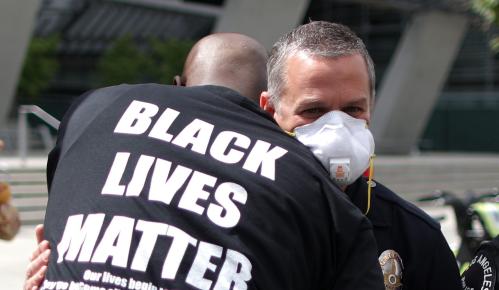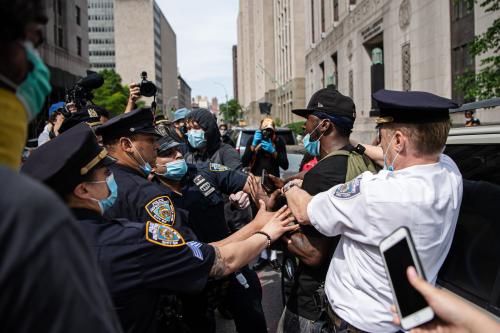“I am concerned about excited delirium or whatever.” These were the words spoken by a fellow police officer as Derek Chauvin knelt on George Floyd’s neck for the final eight minutes of his life. This concern for “excited delirium” may now become part of the case for the defense in the upcoming trial for the murder of George Floyd, as it has for other Black men before him. Just three months shy of Floyd’s murder, officers in Tacoma, Washington had suggested “excited delirium” as the cause of death in the case of another unarmed Black male, Manuel Ellis. And last year in Aurora, Colorado, paramedics injected Elijah McClain with ketamine, for “exhibiting signs of excited delirium”. McClain later died of cardiac arrest after the injection.
Law enforcement officers nationwide are routinely taught that “excited delirium” is a condition characterized by the abrupt onset of aggression and distress, typically in the setting of illicit substance use, often culminating in sudden death. However, this “diagnosis” is not recognized by the vast majority of medical professionals. In fact, “excited delirium” is not recognized by the American Medical Association, the American Psychiatric Association, or the World Health Organization, and it is not listed in the Diagnostic and Statistical Manual of Mental Disorders (DSM-5).
The diagnosis is a misappropriation of medical terminology, used by law enforcement to legitimize police brutality and to retroactively explain certain deaths occurring in police custody. There is no systematic or publicly available data about how this diagnosis is used in relation to deaths in police custody. The limited data available involves small samples in certain states only: In one Maryland-based study, excited delirium was invoked in 11 percent of deaths in police custody and in another Florida-based study, 53 deaths in police custody were attributed to this entity over the past decade.
Further adding to the lack of clarity surrounding this terminology is that “delirium” refers to a well-established diagnosis frequently seen and treated by medical professionals, with a clear diagnostic criteria. “Excited delirium,” however, is not a term that is used in clinical practice nor does it have diagnostic criteria. It inaccurately and selectively combines various signs and symptoms from real medical emergencies such as drug intoxication, psychosis or mania, thereby creating a blanket diagnosis that appears medically legitimate at first glance.
The term “excited delirium” was first used in 1985 by Charles Wetli, a forensic pathologist, to explain a series of sudden deaths in cocaine users, occurring primarily in police custody. Wetli used the same term to explain the deaths of 32 Black women occurring in Miami over the 1980s, proposing that a combination of cocaine use and sexual intercourse had led to their demise. Police subsequently attributed the deaths to asphyxiation by a serial killer.
From the beginning, this terminology has been disproportionately applied to Black people, and has only been used in specific contexts pertaining to encounters with law enforcement. One study looking at cocaine-related deaths in the 1970s and 1980s in Dade County, Florida, revealed that these deaths were more likely to be diagnosed as “excited delirium” when involving young Black men dying in police custody and “accidental cocaine toxicity” when involving cocaine-related deaths in white people.
Despite these highly racist roots, the term gained traction and evolved over the past 30 years into the catch-all diagnosis that it is today, advanced primarily by law enforcement. The “risk factors” for this purported condition include “bizarre behavior generating phone calls to police”, “failure to respond to police presence”, and “continued struggle despite restraint”. The “syndrome” also supposedly endows individuals with “superhuman strength”, and being “impervious to pain”, and remains disproportionately diagnosed among young Black males, underscoring the racist undertones of these “diagnostic features.”
The problem is twofold: It winds up being a convenient scapegoat cause of death after a violent confrontation with law enforcement, and it becomes a justification for police aggression that is unwarranted.
We propose three solutions.
First, medically-trained professionals should be the primary responders and decision-makers in the management of acute medical emergencies, such as drug intoxication or acute psychosis. The management of these medical emergencies should be in line with evidence-based consensus practices. In scenarios where police involvement is unavoidable, de-escalation strategies should be employed – officers currently only have about 8 hours of training in crisis intervention and de-escalation techniques, compared to about 100 hours of training on firearms and defensive tactics. Use of firearms or violent restraints, such as chokeholds restricting blood flow to the brain, are never appropriate medical interventions.
Second, we recommend that the medical community actively engage in denouncing the validity of this “diagnosis.” Currently, it exists largely as a medicolegal construct, with limited review and commentary from medical professionals and organizations. Many of the authors who have published the existing reports in medical literature have financial conflicts of interest with law enforcement agencies and the Taser corporation. The diagnosis is not validated by any clear pathophysiologic theory, pathologic evidence, or unique clinical features. It has been used in an inherently racist manner, insinuating that there is a medical condition predisposing a distinct group of individuals, primarily Black men, to die in police custody. There is no place for silence or inaction – medical societies have a duty to prevent the perversion of medicine for institutional or individual gain.
Third, we recommend transparency in data about police custody deaths. In 2013, Congress passed the Death in Custody Reporting Act which went into effect in December 2014. Yet federal officials have not yet gathered the data and made it public. Data transparency is a critical component of addressing this problem and central to developing evidence-based practices. Meaningful policy changes and accountability are impeded by the lack of accurate reporting.
“Excited delirium” is an imprecise, subjectively defined term, and often applied retrospectively in a manner that lends itself to misuse. It draws upon aspects of real medical conditions such as delirium, psychosis, drug intoxication, and sudden cardiac death, but manipulates them to form a broadly-applicable blanket diagnosis that serves the interests of law enforcement and absolves them of accountability.
The Brookings Institution is committed to quality, independence, and impact.
We are supported by a diverse array of funders. In line with our values and policies, each Brookings publication represents the sole views of its author(s).









Commentary
How “excited delirium” is misused to justify police brutality
August 10, 2020